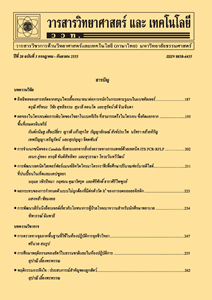การศึกษาความเหมาะสมการผลิตเชื้อเพลิงชีวมวลอัดแท่ง จากเปลือกสับปะรด
Main Article Content
Abstract
บทคัดย่อ
งานวิจัยนี้เป็นการศึกษาความเหมาะสมในการจัดการเปลือกสับปะรดซึ่งเป็นวัสดุเหลือทิ้งทางการเกษตร โดยนำมาผลิตเป็นเชื้อเพลิงชีวมวลด้วยวิธีอัดเย็นโดยใช้น้ำแป้งมันสำปะหลังเป็นตัวประสานเพื่อใช้เป็นพลังงานทดแทนในชุมชน การศึกษาแบ่งออกเป็น 2 ส่วน คือ (1) การศึกษาความเหมาะสมทางเทคนิคซึ่งประกอบด้วยการวิเคราะห์สมบัติด้านเชื้อเพลิงของแท่งเชื้อเพลิงตามาตรฐาน ASTM และการวิเคราะห์ผลประโยชน์ทางสิ่งแวดล้อมในรูปของการลดปริมาณการปล่อยก๊าซเรือนกระจก และ (2) การศึกษาความเหมาะสมทางเศรษฐศาสตร์ของการผลิตเชื้อเพลิงอัดแท่งเพื่อประเมินความเป็นได้ในการบริหารจัดการโดยชุมชนในทางปฏิบัติ ผลการศึกษาพบว่าแท่งเชื้อเพลิงที่ได้มีค่าความร้อนอยู่ในช่วง 3,235-3,389 kcal/kg และมีค่าความชื้น ปริมาณสารระเหย ปริมาณเถ้า และคาร์บอนคงตัวอยู่ในช่วง 12.7-20.5, 56.0-68.9, 3.1-3.6 และ 9.9-20.7 % ตามลำดับ การใช้เชื้อเพลิงชีวมวลอัดแท่งแทนฟืนไม้สามารถช่วยลดการปล่อยก๊าซเรือนกระจกได้ 13.13 kgCO2eq/kg เปลือกสับปะรดแห้งที่ใช้ ผลการวิเคราะห์ความคุ้มค่าทางเศรษฐศาสตร์ พบว่าอัตราผลตอบแทนภายในเท่ากับ 9.4 % มูลค่าปัจจุบันสุทธิเท่ากับ 12,551 บาท และระยะเวลาคืนทุนเท่ากับ 6 ปี 6 เดือน ซึ่งอยู่ในเกณฑ์ที่เหมาะสมต่อการลงทุน โดยปัจจัยที่เป็นความเสี่ยงในการบริหารจัดการและมีผลต่อผลตอบแทนของโครงการมากที่สุดคือจำนวนเชื้อเพลิงที่ผลิตได้ต่อวัน รองลงมาคือค่าแรงคนงาน จำนวนวันที่ผลิต และราคาเครื่องจักร ตามลำดับ
คำสำคัญ : พลังงานทดแทน; เชื้อเพลิงชีวมวลอัดแท่ง; เปลือกสับปะรด
Abstract
The objective of this research is to study the technical and economic feasibility of biomass briquette production from pineapple peel as agricultural residues in order to use as alternative energy in communities. The biomass briquette in this research was produced by cold-press technique mixing with tapioca starch. The technical feasibility study consists of 2 parts: (1) Fuel properties of the briquette and (2) environmental benefit in terms of greenhouse gas emission reduction. The fuel properties of briquette were analyzed according to ASTM standards. The results show that the heating value of the briquette was in the range between 3,235-3,389 kcal/kg. and moisture, volatile, ash, and fixed carbon content were 12.7-20.5, 56.0-68.9, 3.1-3.6, and 9.9-20.7 %, respectively. The using of the briquette instead of fuel wood can help reducing greenhouse gas emission by 13.13 kgCO2eq/kg of dried-pineapple peel. The economic feasibility of briquette production was analyzed using net present value (NPV), internal rate of return (IRR) and payback period (PB). The analysis results show that the production of biomass briquettes from pineapple peel is economically feasible with IRR=9.4 %, NPV = 12,551 THB, and payback period = 6 years and 6 months. Moreover, the sensitivity analysis results showed that the most influential risk factors of the briquette production are number of fuel produced daily, followed by labor wages, number of production days a year, and price of machines, respectively.
Keywords: renewable energy; briquette; pineapple peel


